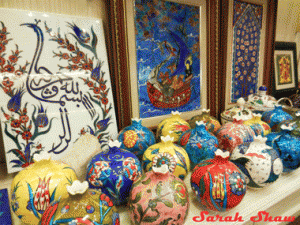 Big cities seem to acquire symbols that are instantly recognizable. For some it is related to their architecture. See the silhouette of the Eiffel Tower and you immediately think of Paris. An outline of the Golden Gate Bridge tells you it’s San Francisco. Other cities seem to be represented by fruit. New York City is the Big Apple. For me, when I remember my visit to Istanbul, I see three images. There is the nazar, or evil eye protector. I also see dervishes represented in all their forms. But whenever I see a pomegranate, I will also remember Istanbul. I noticed early on that pomegranates were everywhere. In talking with a local artist, I learned about Istanbul’s love affair with the pomegranate and how it plays an important part of New Year’s celebrations in Turkey.
Big cities seem to acquire symbols that are instantly recognizable. For some it is related to their architecture. See the silhouette of the Eiffel Tower and you immediately think of Paris. An outline of the Golden Gate Bridge tells you it’s San Francisco. Other cities seem to be represented by fruit. New York City is the Big Apple. For me, when I remember my visit to Istanbul, I see three images. There is the nazar, or evil eye protector. I also see dervishes represented in all their forms. But whenever I see a pomegranate, I will also remember Istanbul. I noticed early on that pomegranates were everywhere. In talking with a local artist, I learned about Istanbul’s love affair with the pomegranate and how it plays an important part of New Year’s celebrations in Turkey.
Above, ceramic pomegranates, found in the Spice Bazaar, are painted with bright colors in Turkish designs.
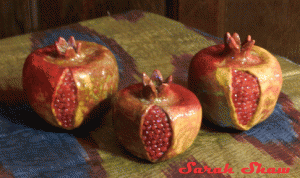 Pomegranates (Punica granatum) originated in Persia, today known as Iran. The fruit is grown on shrubs or small trees and has long been popular for its sweet-sour flavor. The plant is also grown as an ornamental specimen in gardens. Each pomegranate contains somewhere between 200 – 1400 seeds. An Islamic legend says that each fruit contains one seed that has descended from paradise.
Pomegranates (Punica granatum) originated in Persia, today known as Iran. The fruit is grown on shrubs or small trees and has long been popular for its sweet-sour flavor. The plant is also grown as an ornamental specimen in gardens. Each pomegranate contains somewhere between 200 – 1400 seeds. An Islamic legend says that each fruit contains one seed that has descended from paradise.
The ceramic pomegranates, above, are bursting with ruby seeds. These were purchased in the Spice Bazaar.
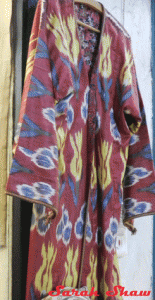 Cultivation of pomegranates quickly spread from Iran and now can be found throughout the Mediterranean and even in the Himalayas of Northern India. It is also popular in Southern China which it reached through trade along the Silk Road. The Spanish introduced it to North America and it can be found in California, Arizona and many places in Latin America.
Cultivation of pomegranates quickly spread from Iran and now can be found throughout the Mediterranean and even in the Himalayas of Northern India. It is also popular in Southern China which it reached through trade along the Silk Road. The Spanish introduced it to North America and it can be found in California, Arizona and many places in Latin America.
The silk kaftan, to the left, was spotted in the Grand Bazaar. It has a beautiful large pomegranate motif in its ikat weave.
The pomegranate owes its popularity to its usefulness. The bark has long been used for curing leather as it is high in tannins. The flowers were used to create dyes for textiles. The fruit is used in cooking and to make juice. The seeds can be eaten raw and are a tasty and colorful addition to a salad. Grenadine, a frequent addition to cocktails, is made from thickened pomegranate juice. Ayurvedic medicine in India has long embraced the pomegranate for it benefits for the heart as well as intestinal problems. While walking around the Galata area of Istanbul, I came across many fresh juice stands with the fruit artfully displayed. You pick your preferred combination and your juice is created to order.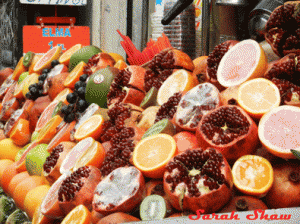
The fresh fruit on display, in the photo on the right, was found at a juice stand in the Galata neighborhood in Istanbul.
Full of symbolism, the pomegranate represents many good qualities people would want for new beginnings. The red color is a symbol for the human heart and denotes life and fertility. The medicinal properties of the pomegranate are a symbol of good health. The abundance of seeds represent prosperity. Many cultures have appreciated these attributes. In China, Buddhists give pictures of ripe, open fruit to a newly wedded couple as a wish for fertility. In Greece, a pomegranate makes a popular housewarming gift.
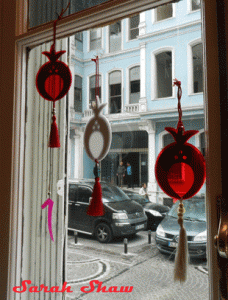 While touring an artist’s gallery I discovered near my hotel, I found her creating a number of pomegranate objects. I asked her about the significance of the pomegranate for Istanbul. She explained to me that it was a perfect symbol for the city. All of the seeds were like the different people of Istanbul. The city is populated by people with many different religious beliefs and from many different ethnic backgrounds. Yet all these individual seeds are all housed in one fruit just as Istanbul is home for so many people and draws visitors from all over the world. I loved many of her creations and purchased several while in her shop.
While touring an artist’s gallery I discovered near my hotel, I found her creating a number of pomegranate objects. I asked her about the significance of the pomegranate for Istanbul. She explained to me that it was a perfect symbol for the city. All of the seeds were like the different people of Istanbul. The city is populated by people with many different religious beliefs and from many different ethnic backgrounds. Yet all these individual seeds are all housed in one fruit just as Istanbul is home for so many people and draws visitors from all over the world. I loved many of her creations and purchased several while in her shop.
Above are some sun catcher’s she has created featuring pomegranates.
I have also chosen her gallery as one of my 12 Best WanderShopping Experiences of 2012 which will be featured in an upcoming post on WanderShopper. Check back to see a photo of the Hand of Fatima sun catcher she created which I also brought home with me.
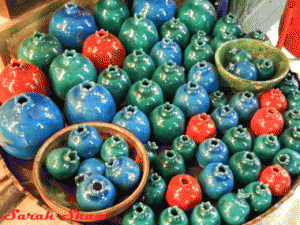 Another story my artist friend shared with me is how people in Turkey include the pomegranate in their New Year’s celebrations. As midnight approaches, you would want to grab a pomegranate and smash it against the ground. The more pieces it breaks in to, the more good luck you will have in the New Year. I also read about other people smashing the pomegranate against their front door as an alternative.
Another story my artist friend shared with me is how people in Turkey include the pomegranate in their New Year’s celebrations. As midnight approaches, you would want to grab a pomegranate and smash it against the ground. The more pieces it breaks in to, the more good luck you will have in the New Year. I also read about other people smashing the pomegranate against their front door as an alternative.
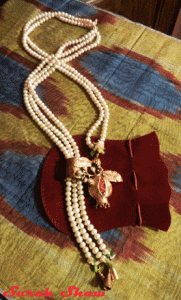 The photo above features a collection of colorful, ceramic pomegranates are gathered in a basket for sale in the Grand Bazaar in Istanbul.
The photo above features a collection of colorful, ceramic pomegranates are gathered in a basket for sale in the Grand Bazaar in Istanbul.
At left, is a special treasure I found in the Spice Bazaar. Strands of pearls are gathered together in a brass pomegranate slide which glistens with ruby seeds. The ends of each strand are capped with brass cones for a very special creation. Enjoying the pictures? Visit WanderShopper’s FaceBook Fanpage to view more pictures of pomegranates in Istanbul as well as other pictures from this incredible destination.
Throughout the world, people from different backgrounds all celebrate the New Year. Each one being like a seed in a pomegranate. Despite our differences, we all enjoy in some way this common holiday. What New Year traditions do you keep each year?